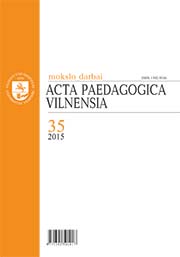Informatinio mąstymo ugdymo užduotys: merginų ir vaikinų sprendimų analizė
Tasks for developing computational thinking: an analysis of girls’ and boys’ problem solving results
Author(s): Valentina Dagienė, Eimantas Pėlikis, Gabriele StupurieneSubject(s): Gender Studies, Education, ICT Information and Communications Technologies
Published by: Vilniaus Universiteto Leidykla
Keywords: informatics education; gamification; computational thinking; the Bebras contest; information technology;
Summary/Abstract: The main purpose of this paper is to represent the notion of the computational thinking for Lithuanian audience. Problem solving and computational thinking are important abilities that pupils should obtain in their daily activities by using different means and techniques. Very little research specifically exploring gender differences in young children’s problem solving and programming abilities exists, most likely because computational thinking is still a very little investigated domain. The paper discusses the issue of pupils’ cognitive abilities on computational thinking and problem-solving in an annually organized contest Bebras on informatics (computer science) and computer fluency. Running the contest for more than ten years, we have noticed that the pupils (and their teachers) consider the contest experience very engaging and exciting as well as a learning experience on computational TASKS FOR DEVELOPING COMPUTATIONAL THINKING: AN ANALYSIS OF GIRLS’ AND BOYS’ PROBLEM SOLVING RESULTS Valentina Dagienė, Eimantas Pėlikis, Gabrielė Stupurienė Summary thinking and problem solving. A Bebras contest is a tool to involve pupils of all grades (the Bebras contest is developed to be run in five age groups from primary to upper secondary school) as the taskssolving activity. The crucial point of the contest is questions (tasks): they focus on the informatics concepts, they are short, attractive, answerable in a few minutes, half of them have the multiple-choice answers and another half have interactive components (solving by dragging, clicking, sorting, etc.). The study focuses on the results of nearly 24 000 students aged 11–18. In the paper, the main focus is on how girls and boys have performed the tasks within different age groups and whether there are any differences or similarities.
Journal: Acta Paedagogica Vilnensia
- Issue Year: 2015
- Issue No: 35
- Page Range: 53-66
- Page Count: 14
- Language: Lithuanian

